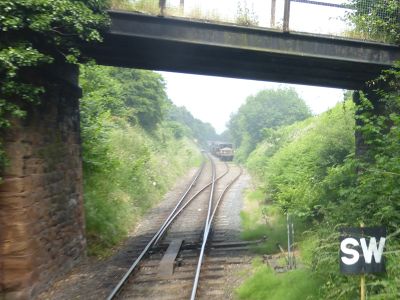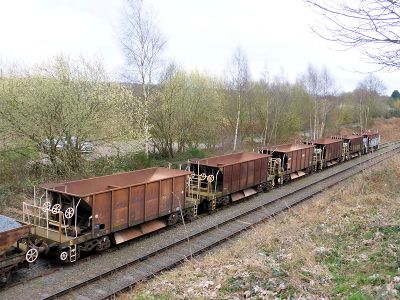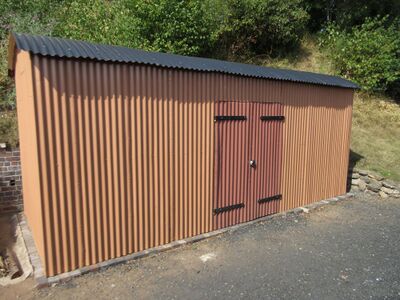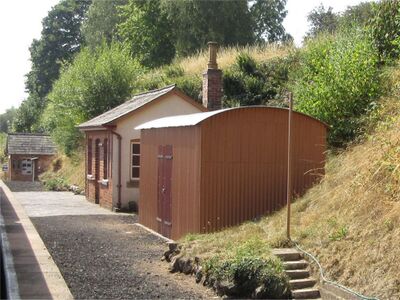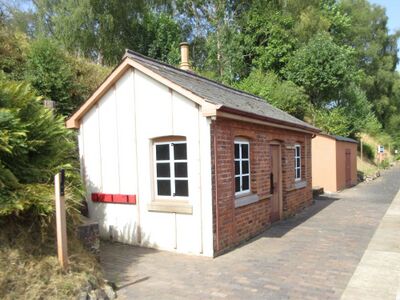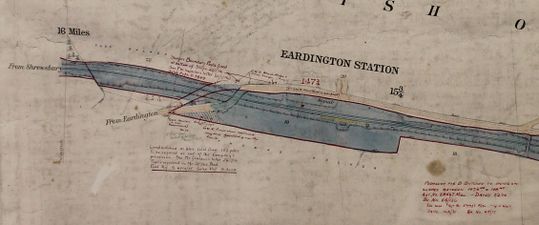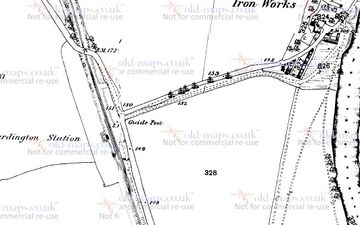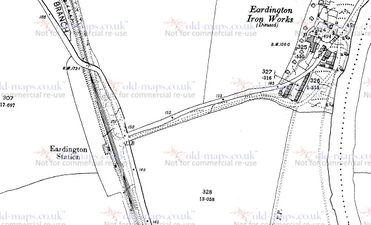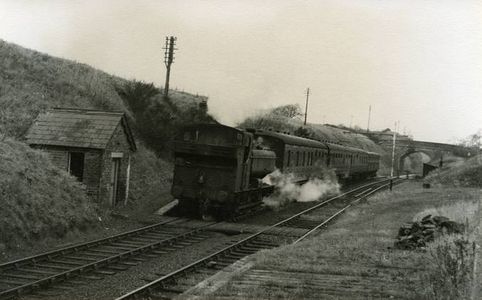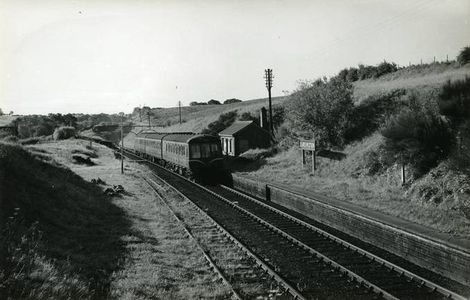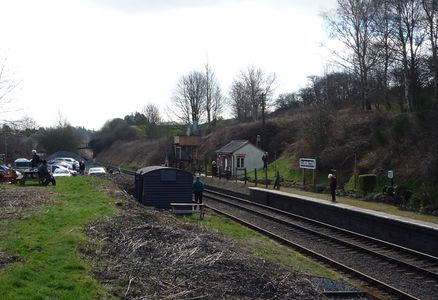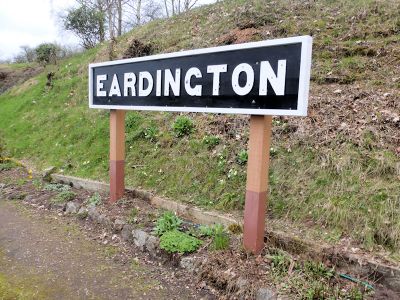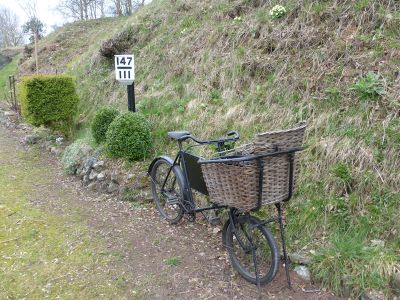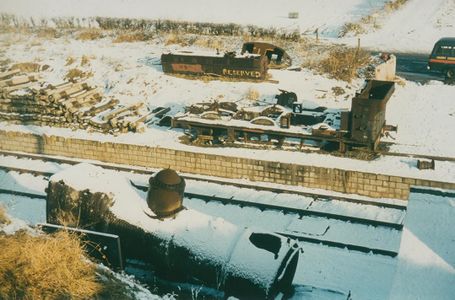Eardington
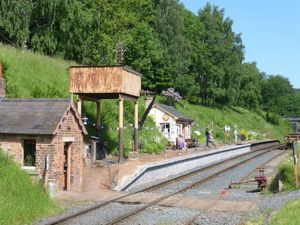
| Up (towards Kidderminster) | Down (towards Bridgnorth) |
|---|---|
| Hampton Loade (2¼ miles) |
Bridgnorth (2¼ miles) |
Eardington, sometimes referred to as "Eardington Halt", is situated on Eardington Bank and located mid-way between Bridgnorth and Hampton Loade at milepost 147¾. Although the station does not feature in daily operations, it resumed use during gala events in 2023 more than 40 years since regular timetabled trains ceased. A dedicated 'Friends of Eardington Station' team under Station Master Steve Downs looks after this wayside gem.
In February 2025 Eardington was awarded "Station of the Year" as the first winner of a new category in the Heritage Railway Association Annual Awards.[1]
Eardington in preservation[edit | edit source]
Restoration and use up to 1983[edit | edit source]
A working party began restoring Eardington at Whitsun 1967. During that year the platform was cleared, the station building was repainted black and white, and other repairs were carried out. Eardington was in operation during the 1967 and 1968 Steam Galas, the latter seeing locomotives watered there for the first time (see below).[2]
The station officially reopened on 23 May 1970 along with Bridgnorth and Hampton Loade, which at the time formed the limit of operations.[3] Eardington was used as an intermediate stopping point and watering place and was sometimes referred to as Eardington Halt. For the seasons 1970 to 1973 inclusive all trains were advertised in the SVR public timetables to call there.
During the period of Sir Gerald Nabarro's chairmanship, plans were made for the possible rebuilding of Eardington as the northern terminus on the line. As well as installing a run-round loop (see below), detailed plans were also prepared for the station to be enlarged and a car park provided, although this was not publicised at the time.[4]
The station became 'request only' from 2 March 1974, the same year that services were extended to run south of Hampton Loade. The 'request' status continued until the end of the 1976 season, although calls were suspended that year because of fire risk.[5]
For 1977 only two round trips were advertised to call on request on Mondays to Saturdays, except Bank Holidays. The following year only one round trip was advertised to call on request, on Saturdays only. No calls were advertised during 1979 and 1980, but in 1981 and 1982 seasons all trains were again timetabled to call on request. No calls were advertised from the 1983 season onwards.[6]
It was removed from regular use thereafter, variously ascribed to the platform edge becoming dangerous or due to the steep gradient, short platform, and low passenger numbers.[7]
Platform restoration 1989 to 2019[edit | edit source]
By 1989 platform coping at the southern end of the platform, adjacent to station building, had been removed after it collapsed. A shortened platform, 152 feet long, remained at northern end.[8] The Friends held a fundraising appeal in 2014 to replace the missing part;[9] it was reported on 27 October 2016 that sufficient funds had been raised to purchase the required replacement GWR bricks.[10]
A project commenced during the January 2018 winter shutdown involving the partial rebuilding of the platform face.[11] Some 8000 engineering bricks recovered from the London – Bristol mainline and donated by Kier Construction were cleaned up by the Friends, and provide a genuine connection to the GWR. The rebuild was undertaken by JSR Construction of Chelmarsh, thus keeping the work local.[12][13] Work was completed on 31 January 2019, giving the station a full length working platform of 300' - roughly 5 coaches - for the first time since 1984. The £41,000 project was aided by donations from the Charitable Trust and the Guarantee Company of £6,500 each, with the remainder being raised by the Friends. The project was completed on time and on budget. [14][15] The rebuilt platform, which incidentally is longer than those at Highley, Hampton Loade and Bridgnorth’s platform 2, can be seen in the main photograph taken during the 2018 Goods Gala. It greatly improved the appearance of the station and progressed its potential use on future gala events.
Returning the station to passenger use 1989 to 2018[edit | edit source]
It had long been the Friends' ambition to stop local trains at Eardington during Galas.
Restoration by a "small group of Bridgnorth C&W volunteers" started in 1989.[16] By summer 1990, Steve Downs was "unofficial stationmaster".[17] It was gradually cosmetically restored by the Friends and occasionally opened to visitors on certain special events, albeit with trains not stopping, from the War Weekend of 25/26 June 1994 onwards.[18]
Part of the cutting behind the station collapsed in January 1991.[19] Quarrying operations behind the station were blamed, and Steve Downes believes the quarry operators did the remedial work. The cutting side was re-profiled, giving the grassy slope we have today. Trees were planted at the top of the bank, to take up moisture from the soil.[20]
On 15 February 1997 a train called specially to set down walkers on an 'Eardington Ramble'.[21]
In 2003 it reopened for trains to call on galas and the 1940s Weekend[22], the first advertised trains since 1982.
On 17 April 2015, the 82045 Steam Locomotive Trust ran a special fundraising train, The Eardington Explorer.[23] This ran between Bridgnorth and Hampton Loade, calling specially at Eardington. The Fund ran a second 'Eardington Flyer' on 22 April 2016.
In 2018 the SVR's retained stonemason Philip Chatfield fitted two stone window cills in place of crumbling stonework.[24]
On 2-3 June 2018 it staged "Eardington 150" to mark its 150th birthday. The station was open to the public on both days with various special attractions (trains did not stop). The event coincided with the SVR's Goods Gala[25].
Proposal for full reopening in 2018-19[edit | edit source]
In November 2018, FCFM Group, the owners of nearby Astbury Hall, submitted plans to Shropshire Council for development of the hall and grounds as a 'holiday venue'. The Design Statement states "The applicant has agreed to assist in financing of the reopening of Eardington Station and to take a direct link between Astbury Estate and the Severn Valley Railway."[26][27] This would see around 300 high quality log cabins at the site adjacent to Eardington Station. FCFM submitted to the SVR an outline proposal for investment such that trains could call regularly providing a link to the new development. The parties agreed to explore how public access could be provided from the estate to the station and what could be achieved while ensuring the character and feel of the station are not undermined.[28]
In February 2019, the SVR submitted a 'Support Comment' in favour of the development to Shropshire Council.[29] In March 2019 the Shropshire Star reported that that plans had been approved.[30]
Use for galas from 2023[edit | edit source]
By 2023 the ORR had given the SVR permission in principle to stop trains there during Galas. The Railway put in place the paperwork and procedures to enable this, as it had not been operational for many years, for the Autumn Steam Gala.[31] For safety reasons, only local trains not longer than the station platform may stop there, and not during hours of darkness.
On 17 May 2024, during the diesel gala, issues with visiting Class 43 power cars 43301 and 43303 caused a northbound HST working to be terminated at the station before returning to Highley. This was the first time an HST had stopped at Eardington, and the first time a train had turned back there in many years[32].
Eardington siding[edit | edit source]
Opposite the station platform is a dead-end siding which is accessed by a two-lever ground frame at the south end. This is released by the Highley-Bridgnorth long section token, and was commissioned in 1976.[33]
The original siding at Eardington, which pre-dated the opening of the station itself,[note 1] had been removed by BR in 1964 after closure of the line, but was reinstated in the early days of the SVR. In summer 1972 under Sir Gerald Nabarro's chairmanship, contractors began work to convert the siding into a passing loop at the then not insignificant cost of £8,000.[note 2] The loop was intended to accommodate a locomotive and 10 coaches, with a new concrete block-faced platform being built incorporating the cattle dock at the south end. A small signal box on the site of the cattle dock was to be added later. These works would have occupied most of the then car park area, so the small field above the station building was partially levelled to form a new car park which would have been accessed from the road at the north end.[2] Later that year, during preparation for commissioning the signalling between Bridgnorth and Hampton Loade, an extra token machine was installed in Bridgnorth signal box to cater for the Eardington loop.[34]
The installation of the passing loop was seen as part of a plan by Sir Gerald Nabarro to abandon Bridgnorth,[note 3] which led to much unrest on the SVR at the time. In fact the connection at the north end would have been too tight for most locomotives.[4] However by May 1973 Nabarro had stepped down from the SVR(H) and Guarantee Company Boards. An EGM was held that month to consider the impact of the proposed Bridgnorth bypass. Richard Dunn advised shareholders and members via SVR News that "I have no reason to reverse my opinion of 1968 that Eardington was not a suitable permanent terminus to the line, owing to the difficulties of road access and inadequate parking space."[35]
In early 1974 the Board reported that "The circumstances under which Eardington loop was planned have so altered that it is unlikely to be needed. It is proposed to convert it to a siding, controlled from a ground frame at the south points, with the proposed platform area levelled off to form a loading bank and car park."[36] By winter 1974-5 the loop had been converted to a siding to for PW use. The two points at the north end which formed a crossover were both removed; the former point in the main line was reused at Arley while the point from the loop was taken to Bridgnorth for use in the loco yard. The single-bladed trap at the south end was not considered suitable for a siding opening onto a passenger carrying line, so was replaced by a double-bladed trap.[37]
It was around this time the pre-preservation loading gauge on the goods siding, and the cattle dock on the loading dock, were both removed. Both feature in early preservation images.
In early preservation items of rolling stock were stored there before being restored to use, including carriages 2701, 4399, 26880 and 27270; and Regent Oil & Texaco Aviation Fuel Tank Wagon 345. Since that time the siding is regularly used for storing Permanent Way rolling stock.
-
Eardington ground frame in 2015
-
Ballast wagons in Eardington siding
Current and former points of interest[edit | edit source]
Goods Lock Up[edit | edit source]
A number of stations on the Severn Valley branch were provided with a Goods Lock Up, a small corrugated iron hut where parcels and other merchandise traffic could be securely stored while awaiting collection or delivery. Lockups were generally built to a standard GWR design, although with many detail differences. Lengths also varied, with 10ft, 14ft and 20ft being commonplace. Surviving lockups can be seen on Platform 1 at Hampton Loade and in the yard at Arley.
At one time, Eardington also had a similar lockup. It was later removed, probably after the station became unstaffed in 1949, although the footprint of the building was still visible in the 1950s. It was covered by a landslip when part of the cutting behind the station collapsed in January 1991 (see above). The site has now been excavated by volunteers and a replica Goods Lock Up was completed in 2025.[38][39]
-
The new goods lockup (August 2025_
-
View looking south
-
View looking north
Ground Frame hut[edit | edit source]
Access to the original siding was by two ground frames installed in 1893.[note 4] The South Frame remained in use until closure and was enclosed in a hut, similar to a small signal box, with windows on three sides to improve sighting. The hut was later acquired by the Preservation Company at the fledgling Welshpool and Llanfair Light Railway and erected at Castle Caereinon station as a passenger shelter. After that use ended, the W&LLR made contact to ask if Eardington would like it returned. The hut was inspected on 11 March 2010 and subsequently dismantled and transported to Eardington where it awaits re-erection[40].
Locomotive watering facility[edit | edit source]
The original station served as little more than a halt and therefore had no watering facilities. A water tank for Eardington was acquired by the Severn Valley Railway Society from the Netherton Goods Branch at Withymoor, Netherton (near Dudley) in the summer of 1967 and transported to Eardington. It was installed in time to be used for the 1968 Steam Gala. It was assisted in part by school parties from the The Royal School Wolverhampton under its history teacher, Brian Kingshott.[41] The decision to install the SVR’s first proper watering facility at Eardington rather than Bridgnorth was due to Eardington having naturally soft water compared with very hard water at Bridgnorth.
At opening in 1970, the timetable allowed a 5 minute stop southbound at Eardington for locomotive watering; passengers frequently took the opportunity to photograph the locomotive or buy pop and sweets which were sold at the station. Once watering facilities were installed at Bridgnorth, this was reduced to one minute, effectively ending this practice.
Unused for some years and heavily perforated, the water tank was removed on 22 April 2021 using the Cowans Sheldon 30-ton steam crane. The intention was to assess whether the tank is reusable elsewhere and, if the tank could be saved, a low priority project would replace the inauthentic LNWR pattern tank at Bewdley to create a more Great Western feel.[42] As of 2024[update] it is still in the station yard.
-
The tank is removed in April 2021 (Chris Bond)
Lamps[edit | edit source]
An electricity supply has never been installed. The Friends have developed a collection of vintage Tilley lamps with a railway provenance, to light the station after dark when open for galas and special occasions.[23] Eardington is the only remaining station in the UK that is lit entirely by oil lamps. The permission granted in 2023 by the ORR is conditional upon trains not stopping after darkness.
In March 2021 the SVR’s YouTube channel included a video Eardington’s hidden gem – lighting the way for heritage rail on the Severn Valley Railway featuring volunteer lampman Phil Harris.
In 2023 a new post and oil-lit and 'Eardington' lettered luminaire was commissioned opposite the lamp hut, to illuminate the foot crossing[43]. Sadly, in April 2024 two of the Tilley lamps were amongst a large number of signs, lamps and lanterns stolen, which were then added to the Heritage Railway Stolen Items Register.[44]
Former Bath Road turntable[edit | edit source]
An electrically powered Ransom Rapier 65'3" standard-pattern over-girder turntable, originally from Bristol (Bath Road) depot, is stored at Eardington. It is intended for the Bridgnorth turntable project. This film shows the turntable's removal from Bristol and transport to Eardington.
Pannier Tank boiler[edit | edit source]
For some years from the winter of 1978-79 a GWR Collett 5700 class 0-6-0PT boiler was stored on the platform. This came from GWR Pannier 3612, which was dismantled at the station[45].
Weighbridge[edit | edit source]
Eardington also had a weighbridge, sited near the main gates. Only the brickwork of the pit survives[46].
Swindon works traverser[edit | edit source]
In 1978, SVR volunteers, working with the Manpower Services Commission, dismantled and removed a traverser from Swindon Works. This was then stored at Eardington to be used as part of a planned expansion of the carriage works at Bewdley. The plans were abandoned when the much larger goods shed at Kidderminster became available in 1985, and the traverser was scrapped.
TV and film[edit | edit source]
The station was a location in a chase scene in the film Candleshoe.
Steve Downes, the Station Master, is a member of acoustic trio 'Whalebone'. A music video of the Simon & Garfunkle classic 'The Boxer' was filmed at the station in 2011[47][48].
Model[edit | edit source]
Tunnel Lane Model Railways produced 7mm 3D printed models of the station building and lamp hut, offered for sale at the 2023 O Gauge Get Together event[49]
Eardington history before preservation[edit | edit source]
- 1862: From opening, Eardington had no passenger facilities. Eardington Siding served the nearby Upper Forge and Lower Forge, two local ironworks located respectively west and east of the line and joined by a 750 yard long navigable canal tunnel. In 1864 a siding connection to Lower Forge was proposed but never built. The 1867 service timetable showed the siding was served by two daily goods workings in each direction, with five minutes allowed for loading and unloading. [40][6]
- 1868: Eardington Station was opened by the GWR on 1 June 1868, some six years after the opening of the Severn Valley Railway.[50]
- 1893: The station platform was extended.[6]
- 1899: The ironworks closed.[6]
- 1922: GWR staff records for 1922 show the station had a staff of 2, the station master and a Gatewoman.
- 1931: The station lost its station master, coming under the control of Highley.[51]
- 1949: BR reduced the station to unstaffed status after 1 April 1949.[50]
- 1952: The first noted instance of the station being referred to as "Eardington Halt" in a BR timetable.[51]
- 1959: The goods loop was reduced to a siding, accessed from the south end only.[50] The station was still called "Eardington" in the 1959 BR Working Timetable.
- 1963: The station closed when passenger traffic ceased on 9 September 1963.[50]
- 1964: The former goods loop siding was completely removed.[50]
| Passenger Traffic | Freight Traffic | |||||
|---|---|---|---|---|---|---|
| Year | Tickets issued | Parcels despatched | Revenue (£) | Tons received & despatched | Revenue (£) | Total revenue (£) |
| 1903 | 5,944 | 778 | 290 | 1,493 | 609 | 899 |
| 1913 | 6,690 | 961 | 311 | 1,704 | 464 | 775 |
| 1923 | 5,267 | 2,259 | 389 | 2,355 | 1,275 | 1,664 |
| 1933 | 3,361 | 438 | 150 | 604 | 217 | 367 |
| 1938 | 2,075 | 277 | 90 | 1,434 | 273 | 303 |
Early Booking Porters and Station Masters at Eardington[edit | edit source]
The first description of ‘Station Master’ in GWR records is in 1879. It seems likely that where no station master is shown, then the booking porter supervised the station.
| Name | Born | From | To | Comments |
|---|---|---|---|---|
| John George Brecknell | 1845 Abberley, Warwickshire | May 1868 | August 1879 | Booking porter when the station opened in 1868 and may have supervised the station, the census of 1871 describing him as Station Master. Previously employed at Bridgnorth. |
| Stephen Floyd | 1852 Tackley, Oxfordshire | August 1879 | January 1883 | Station Master |
| William Sherwood | 15 November 1846 Bidford, Warwickshire | January 1883 | January 1887 | Booking Porter. Previously employed at Hartlebury on the branch, amongst other stations. Later Station Master at Hampton Loade and Berrington. |
| Henry Powell | 1836 Ombersley, Worcestershire | January 1887 | June 1887 | Booking Porter. Served his entire railway career on the Severn Valley Branch, and censuses 1871 and 1881 record him as station master at Highley. |
| William George Cleeton | 1859 Broseley, Shropshire | May 1890 | August 1891 | Booking Porter, then Station Inspector, Census of 1891 records Station Master. Employed at Coalport, Buildwas and Bridgnorth before Eardington, and later Station Master at Hampton Loade and Berrington. |
| George Walter Cooke | 1865 Eardington, Shropshire | August 1891 | April 1930 | Station Master |
| Edward Morris Casey | 1874 Abergavenny | April 1930 | March 1931 | Station Master |
Historic maps of Eardington Station[edit | edit source]
- Original GWR plan of the station.
- 1884 OS map showing the position of the station in relation to the river and iron works. Unfortunately, the station lies across the join between two maps and the track detail is not very clear.
- 1903 OS map on which the loop and headshunt can be seen more clearly. By this date, the iron works was disused.
- 1905 GWR schematic plan of Eardington giving siding capacity and other details.
-
GWR plan
-
1884
-
1903
-
1905
Gallery[edit | edit source]
-
Ex-GWR Pannier 3788 calls at Eardington in November 1960 (Sellick Collection)
-
A similar view of Eardington, taken in March 2015
-
The station running in board
-
An old bicycle on the platform next to milepost 147¾
-
1977 Candleshoe image filmed from the Eardington Road Bridge featuring 4566 and three of the SVR's GWR carriages
-
Ex-GWR 0-6-0PT 3612's boiler on Eardington platform, minus chimney, frames, cab roof and tanks in the yard
See also[edit | edit source]
Notes[edit | edit source]
- ↑ The 1867 service timetable refers to trains stopping at Eardington Siding. No detailed OS map appears to exist showing the layout of the station area between the opening of the line in 1862 and the station itself in 1868. It is therefore not totally clear whether there was a separate goods loop/siding from opening, or whether trains simply stopped on the running line. The siding was certainly present after that time, although the Ground Frames appear to date to 1893 when the name plates were cast; presumably the siding was accessed by simple points levers prior to that time.
- ↑ £8,000 in 1972 equates to around £135,000 in 2023. For context, the whole section of the railway between Bridgnorth and Alveley had cost only £25,000 just two years earlier.
- ↑ Although officially described as a passing loop, discontented members believed it was actually intended as a run round loop at what would become the northern terminus following the closure of Bridgnorth.
- ↑ Steve Downs' notes include the information that the name plates for Eardington North Ground Frame and Eardington South Ground Frame were cast on 28 August 1893; the installation date was presumably shortly after that time.
References[edit | edit source]
- Rail Chronology, Eardington station (Retrieved 20 September 2023). Richard Maund and Allan Brackenbury's research, an earlier version of which appeared in Railway & Canal Historical Society Railway Chronology Group Co-ordinating Newsletter no. 49, January 2007.
- Early Booking Porters and Station Masters at Eardington information from Chris Haynes' research of GWR records and public records.
- ↑ HRA Annual Awards 2025.
- ↑ 2.0 2.1 SVR News 25, Eardington Station, David Marchant
- ↑ SVR (Holdings) Ltd prospectus April 1972
- ↑ 4.0 4.1 Marshall (1989) p. 180.
- ↑ Minutes of SVR 10th Annual General Meeting
- ↑ 6.0 6.1 6.2 6.3 Marshall (1989) p. 103.
- ↑ Wikipedia
- ↑ SVR News 92 p.2, SVR News 100 p.35, SVR News 109 p.19, SVR News 122 p.44, SVR News 127 p.45, SVR News 192 p. 30
- ↑ SVRA Working Members Newsletter November 2014
- ↑ Eardington Station Twitter Feed, retrieved 1 November 2016
- ↑ 'Platform' magazine, 2018 Issue 4, p.5
- ↑ SVRLive 'Eardington Station' 13 January 2018
- ↑ 'SVRLive Winter Works 2018' 16 January 2018
- ↑ SVR Live February 2019
- ↑ Smith, R., 'Severn Valley Railway volunteers proud to unveil new platform', Shropshire Star, 1 March 2019 (Retrieved 3 March 2019)
- ↑ SVR News 100 p.35, SVR News 127 p.45
- ↑ SVR News 100, p.31
- ↑ SVR News 111 p.36
- ↑ SVR News 100 pp.18 and 36, SVR News 101 p.31
- ↑ Eardington Facebook 24 June 2020 (Retrieved 23 April 2024)
- ↑ Alan Thwaites' image 15 February 1997 (Retrieved 6 June 2014)
- ↑ SVR News 142, p.54/5
- ↑ 23.0 23.1 SVR Online Forum
- ↑ Eardington Facebook page 7 July 2020 (Retrieved 23 April 2024)
- ↑ SVR's PR on Shropshire Live website 4 June 2018 (Retrieved 24 June 2018)
- ↑ Article on the proposed reopening in the Shropshire Star
- ↑ Planning application for Astbury Hall on Shropshire Council web site
- ↑ SVR announcement 7 December 2018
- ↑ SVR Support Comment on Shropshire Council web site
- ↑ Astbury Hall: Plans backed to transform former KK Downing estate into luxury leisure resort Shropshire Star (retrieved 25 May 2019)
- ↑ Longhorn, Danny, ' 'Vulcan' joins SVR Gala line-up, and Eardington welcomes first arrivals in 41 years', Rail Business Daily, 21 July 2023 (Retrieved 25 July 2023)
- ↑ SVR News 226, Summer 2024, pp. 41 & 50
- ↑ Severn Valley Railway S&T Department (unofficial) website.
- ↑ SVR News 26, Signal & Telecommunications Department Notes
- ↑ SVR News 27, The Proposed Bridgnorth By-pass, R.H. Dunn
- ↑ SVR News 31, Boardroom Notes, David Mellor
- ↑ SVR News 34
- ↑ Posters and photographs on display at Eardington, April 2024 (general history and replacement project)
- ↑ SVR News 100 pp.18 and 36, SVR News 101 p.31 (cutting collapse date)
- ↑ 40.0 40.1 "Eardington Station – A Miscellany." Text and Photos – Steve Downs. Information on public display at Eardington, April 2024
- ↑ Robert Betts and Nick Neath in Unofficial SVR Facebook post 22 April 2021
- ↑ Branch Lines May 2021
- ↑ Eardington SVR Facebook post 14 December 2023
- ↑ SVR X (formerly Twitter) post 17 April 2024
- ↑ SVR News 50.
- ↑ Eardington Facebook post 26 June 2020 (Retrieved 23 April 2024)
- ↑ Heritage Railway 6 July 2011, p. 22
- ↑ The Boxer, Whalebone, music video on YouTube (2011)
- ↑ SVR O Gauge Get Together Facebook post.2 October 2023 (Retrieved 13 October 2023)
- ↑ 50.0 50.1 50.2 50.3 50.4 SVR Souvenir Guide, Ninth Edition
- ↑ 51.0 51.1 SVR News 201 'Eardington News' (Steve Downs)
- ↑ Nabarro (1971) p. 55.
Links[edit | edit source]
- Sharpo's World photos at Eardington, showing station building & yard area
- "To Eardington" by Sammy B Videography on YouTube
- Eardington Station SVR on Facebook
- Eardington Station on X (Twitter)
| ||||||||||||||||||||
